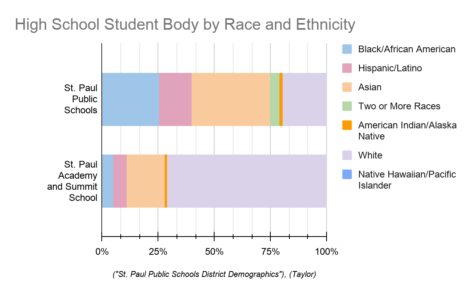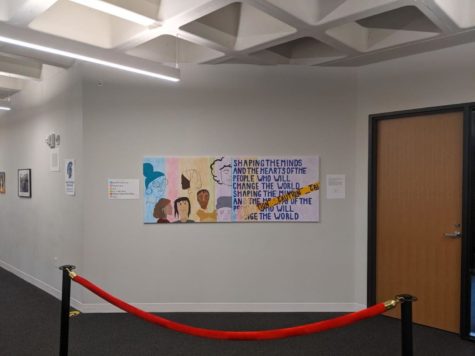[ART REVIEW] Garcia critiques lack of student diversity through art installation
The painting is a translated version of a graph Garcia created from data collected by SPA’s admissions office and provided by Dr. Naomi Taylor, Director of Intercultural Life.
It is an open secret that St. Paul Academy is a predominantly white school. Founded in 1900 (without the Summit School at the time, as it was not founded until 1917), it would be over five decades until Brown v. Board of Education ruled that the racial segregation of schools is unconstitutional, and even then the ruling only applied to public schools. Although the racial demographic of SPA has changed over time, there are still immense disparities between the amount of white students and the amount of students of color. These disparities are mostly due to the systemic income inequality between white and BIPOC households. According to a 2016 study by the Pew Research Center:
“Households headed by a Black person earn on average little more than half of what the average white households earns. And in terms of their median net worth, white households are about 13 times as wealthy as Black households – a gap that has grown wider since the Great Recession.”
Since SPA is a private school that relies on students to pay tuition every year in order to attend, it’s no wonder that there is a clear gap between the amount of white students who are enrolled compared to the amount of BIPOC students. Despite these apparent discrepancies, SPA tends to keep its lack of diversity swept under the rug. Senior Karla Garcia, however, wants to get rid of that rug altogether.
In her painting SPA by the Numbers, Garcia uses SPA’s diversity statistics to create a tableau reflecting the cost of racial homogeneousness, especially in educational settings. Garcia wrote in her artist’s statement:
How can we, SPA students, change the world if our community does not reflect the world we wish to change?
“My work is an examination of the lack of racial and ethnic diversity in the Upper School of St. Paul Academy and Summit School. The St. Paul Public Schools’ high school student demographic engages more fully with the vast diversity of the community within which its schools are located… I want to highlight the beauty of diverse communities and schools juxtaposed with images connoting St. Paul Academy and Summit School, which time and time again tiptoes around conversations about race even when their core aspirations include creating well-versed students. I would like to pose a question to students, families, teachers, administrators, and the board of trustees. If students are to change the world, should not the school that is shaping their minds and their hearts fully encompass the communities they will change?”
The painting is a translated version of a graph Garcia created from data collected by SPA’s admissions office and provided by Dr. Naomi Taylor, Director of Intercultural Life. Garcia then compared the graph to one created with St. Paul Public Schools’ data, and the difference was striking.

“When I reached out to Dr. Naomi Taylor, she provided me with the racial and ethnic data for high school students… I found a stark contrast in the transparency of data between St. Paul Public Schools and SPA. Student demographic data for St. Paul Public Schools was easy to access, well-documented, and had contact information for questions,” wrote Garcia in her Literature of Resistance project write-up, graciously shared to me by Garcia and her teacher, Ms. Amanda Minoff.
My hope is that someday after all the repeated messages students have given — one conversation, one open letter, one research group, one art piece — SPA’s eyes will be opened and maybe something will finally be done.
— Karla Garcia
“I unpacked the idea that if SPA were more upfront about the lack of students of color and didn’t tiptoe around these conversations, the environment surrounding students of color would be very different. If SPA could acknowledge that its percent of Black students — five — by no means reflects the twenty-five percent of St. Paul [Public School]’s Black students…”
While the message of SPA by the Numbers is incredibly moving, the painting itself is beautiful. The color palette, the composition, the variety of style — everything about the piece perfectly ties together Garcia’s message. The utilization of SPA’s slogan (“Shaping the Minds and Hearts of People Who Will Change the World”) covered with CAUTION tape captures its hypocrisy. How can we, SPA students, change the world if our community does not reflect the world we wish to change? The faint image of a shushing finger in the lower right area of the painting calls out SPA’s hush-hush behavior around its diversity and lack of administrative responsibility. Each aspect of the painting has purpose. And while the cartoon-like design of the persons featured in the piece can soften its message, the differences of style only contribute to the desire for diversity that permeates the work.

And even though it is (hopefully) a sign of progress that SPA’s administration allowed for such a scathing piece of art to be hung in its hallways, Garcia remarked that they only allowed her to do so as long as she specified that the painting was created for class credit. Conveying that students are only permitted to critique the school when the critique is a part of a school program is just another example of SPA’s pitfalls in the discussion around race and equity.
“I have seen the repeated attempts by BIPOC students and myself trying to relay this same oppression to SPA students, administration, staff, and families over and over again for many years, and each time it fails. I have had conversations with Head of School Bryn Roberts, I saw extensive Youth Participatory Action Research on race relations at SPA being done my freshman year, I saw open letters posted, and each time this issue is dismissed. All these forms of resistance should work. There is no reason why they should be ignored by administration; however, they are. SPA doesn’t have an excuse to not listen after repeatedly being told the lack of BIPOC is a problem,” wrote Garcia in her Literature of Resistance report. “Art is one more way to explain it, and my hope is that someday after all the repeated messages students have given — one conversation, one open letter, one research group, one art piece — SPA’s eyes will be opened and maybe something will finally be done. Maybe, just maybe, it will lead to a response.”
Mimi Huelster is the Illustrator on RubicOnline. This is her second year on staff. While in self-isolation, you can find her drawing, making toast, and...